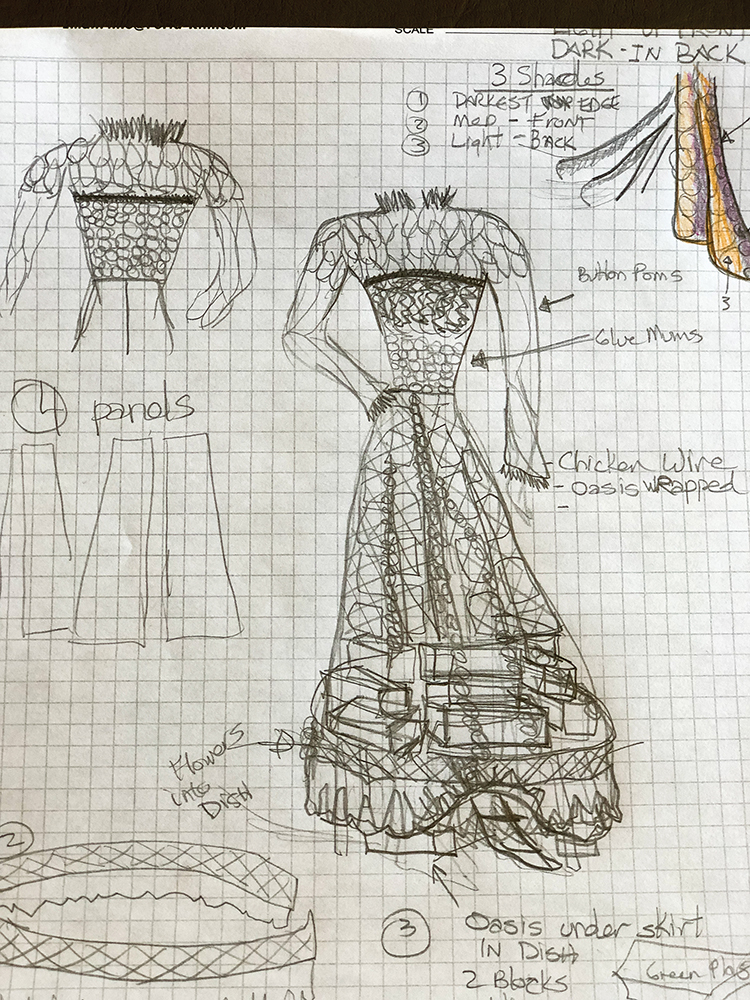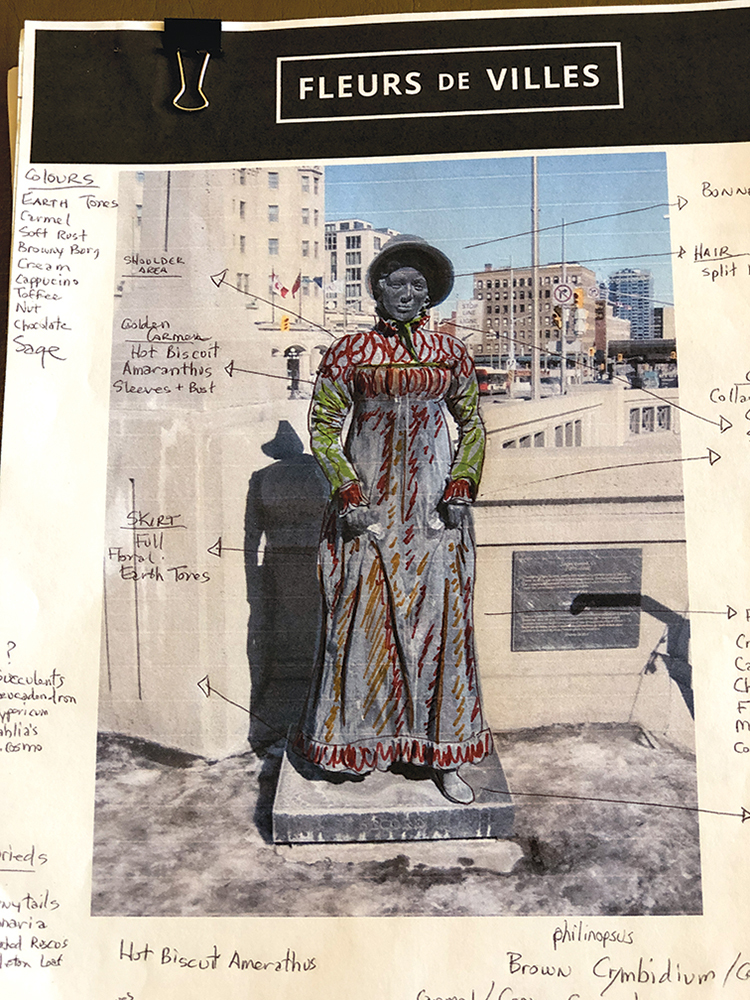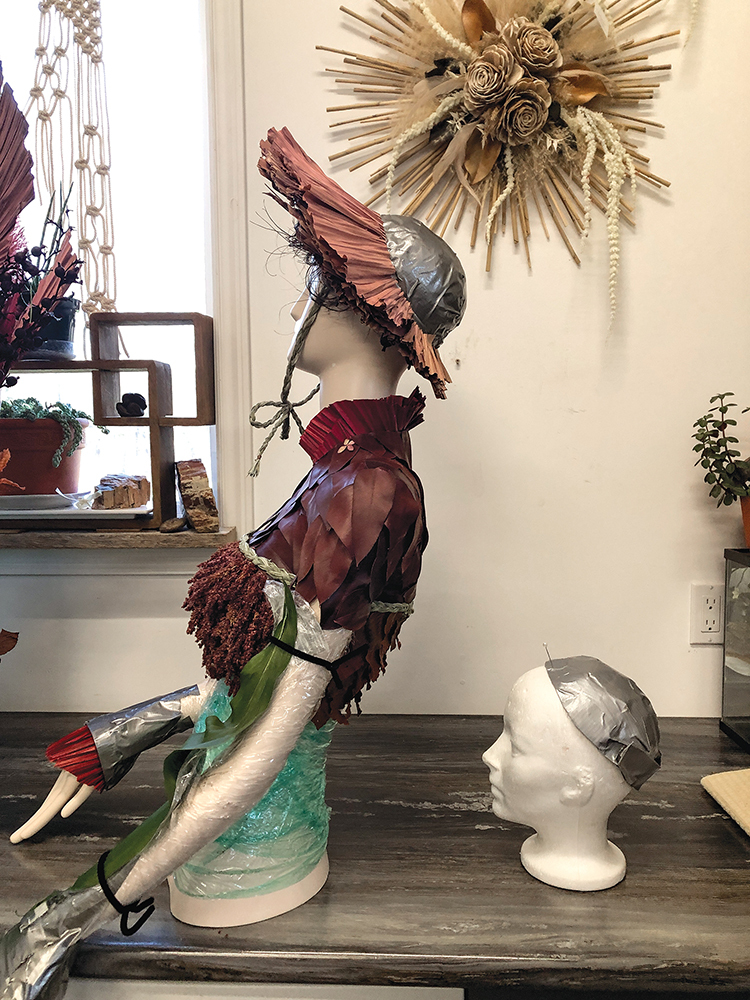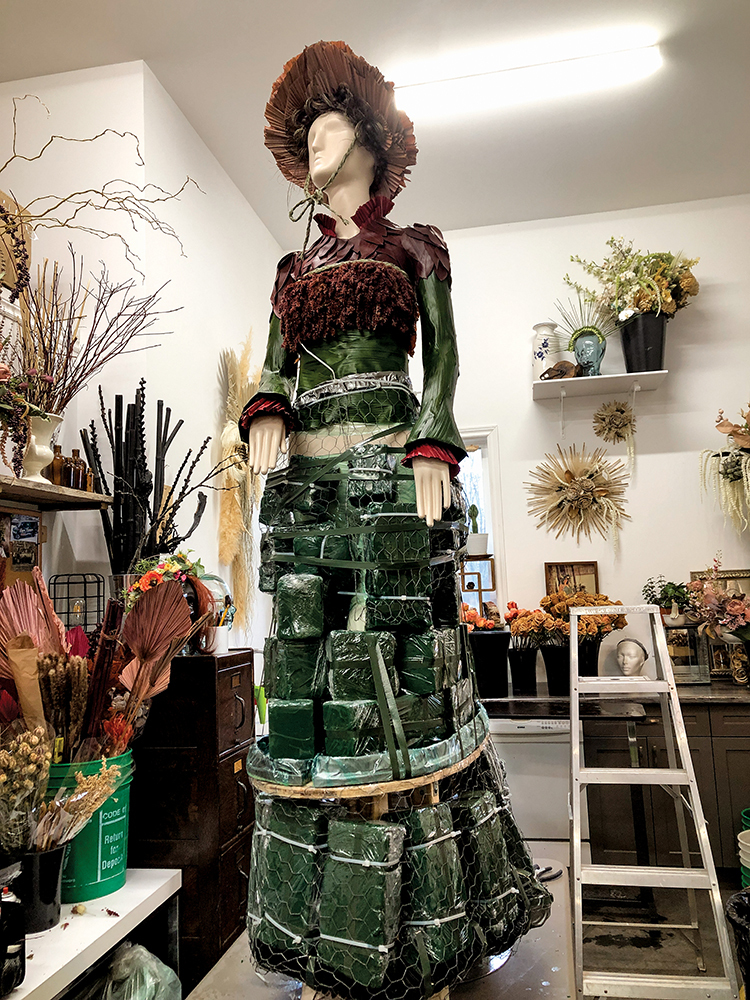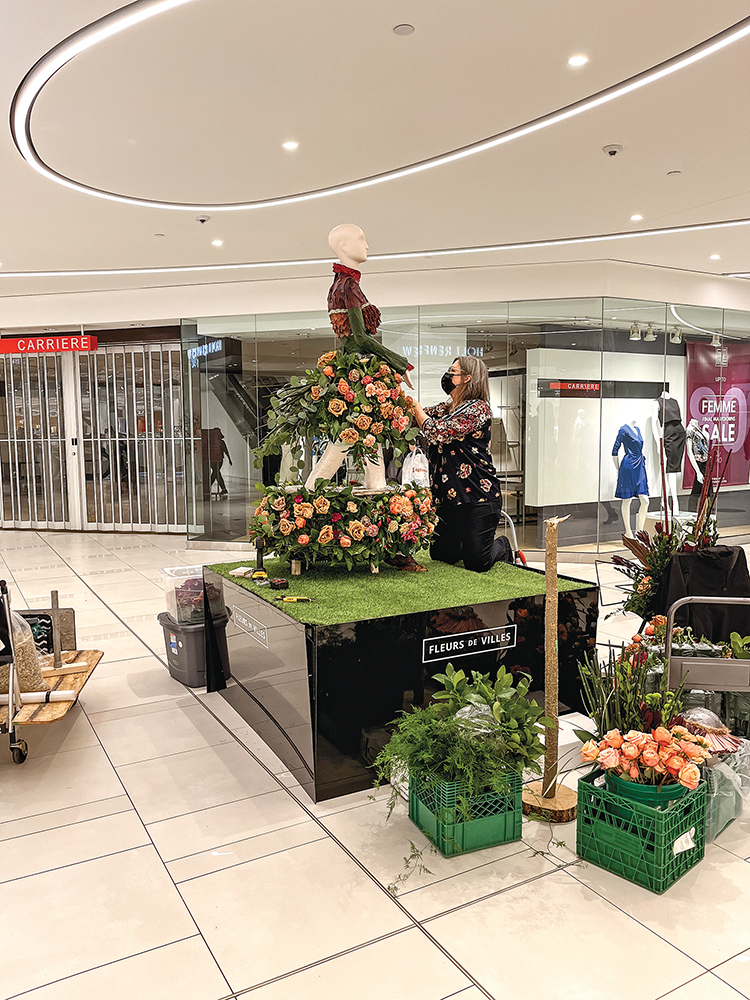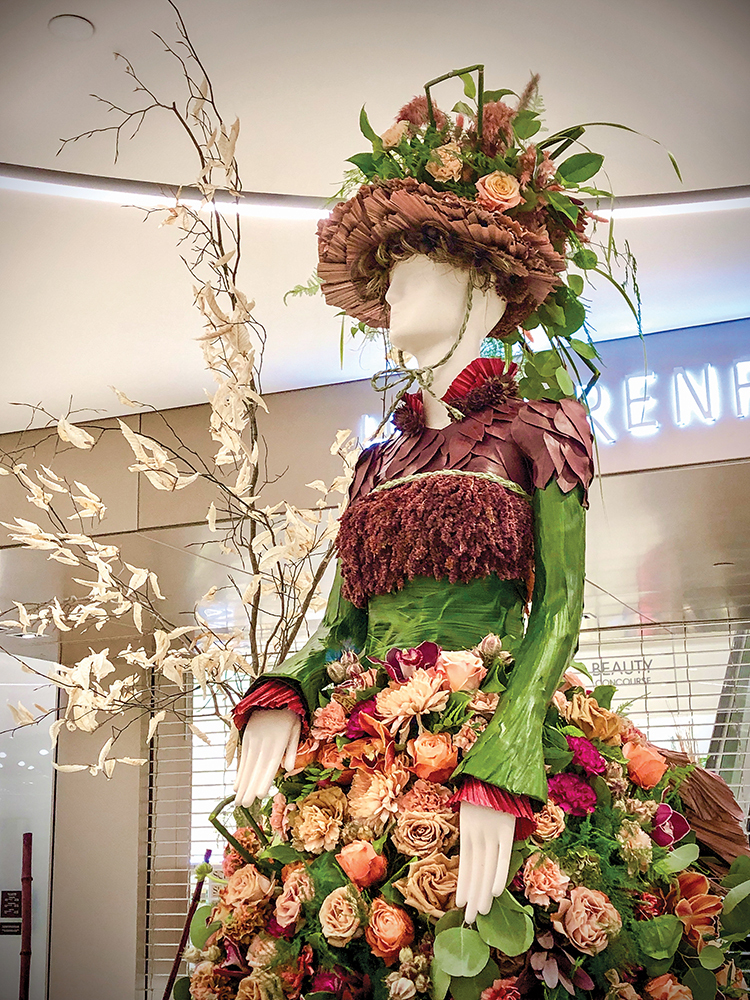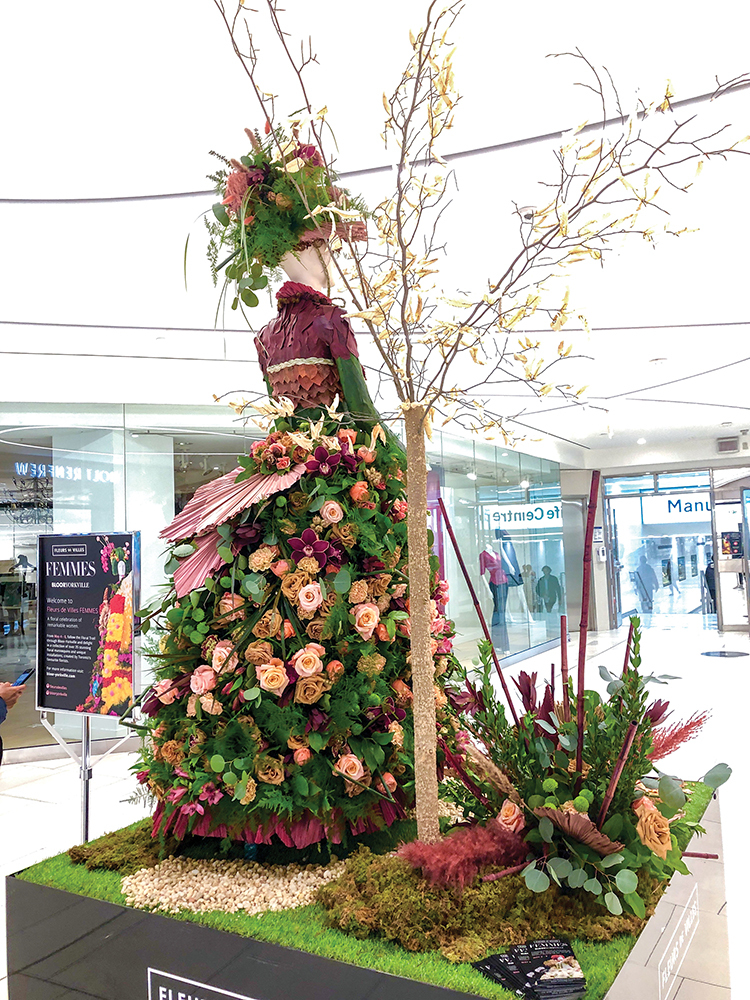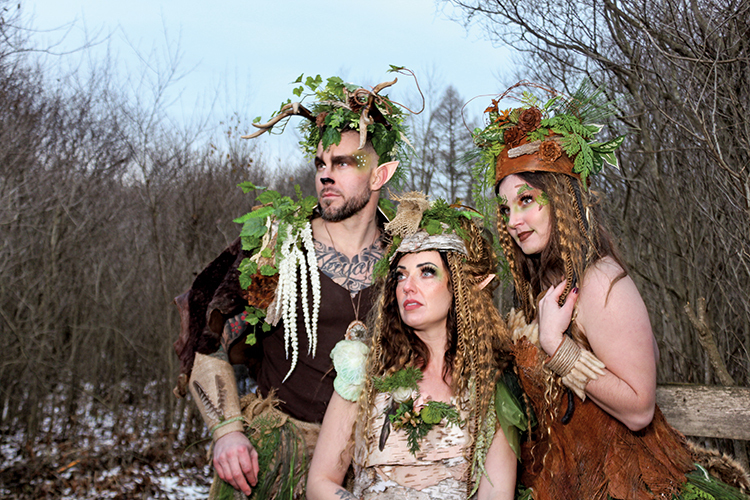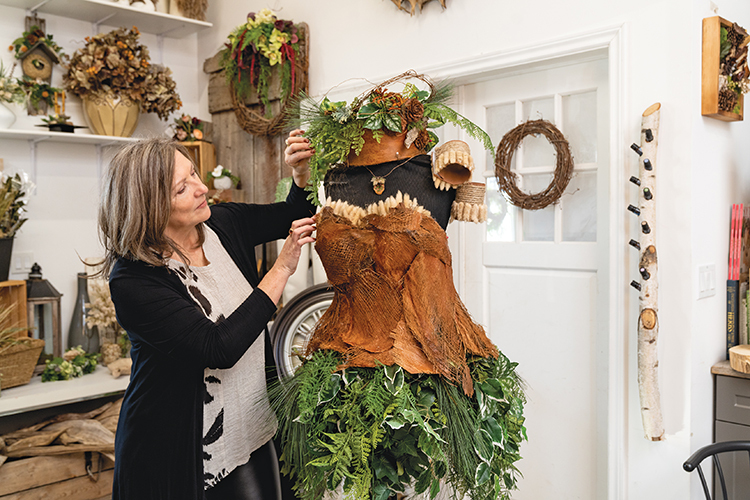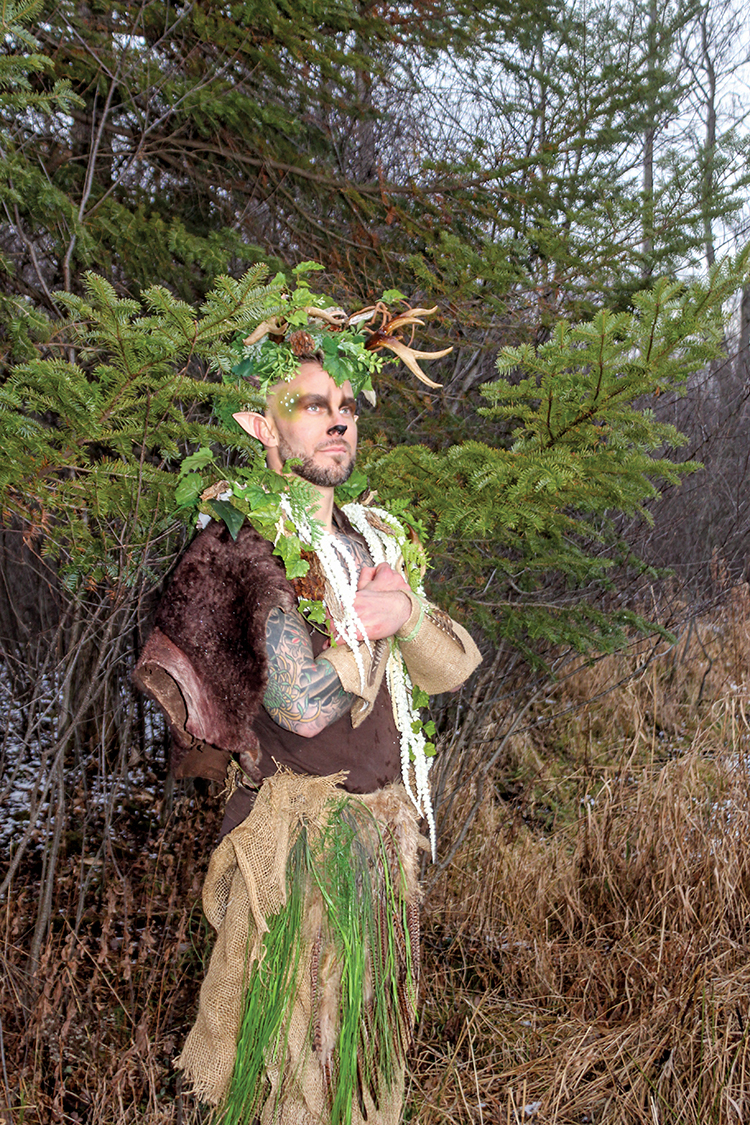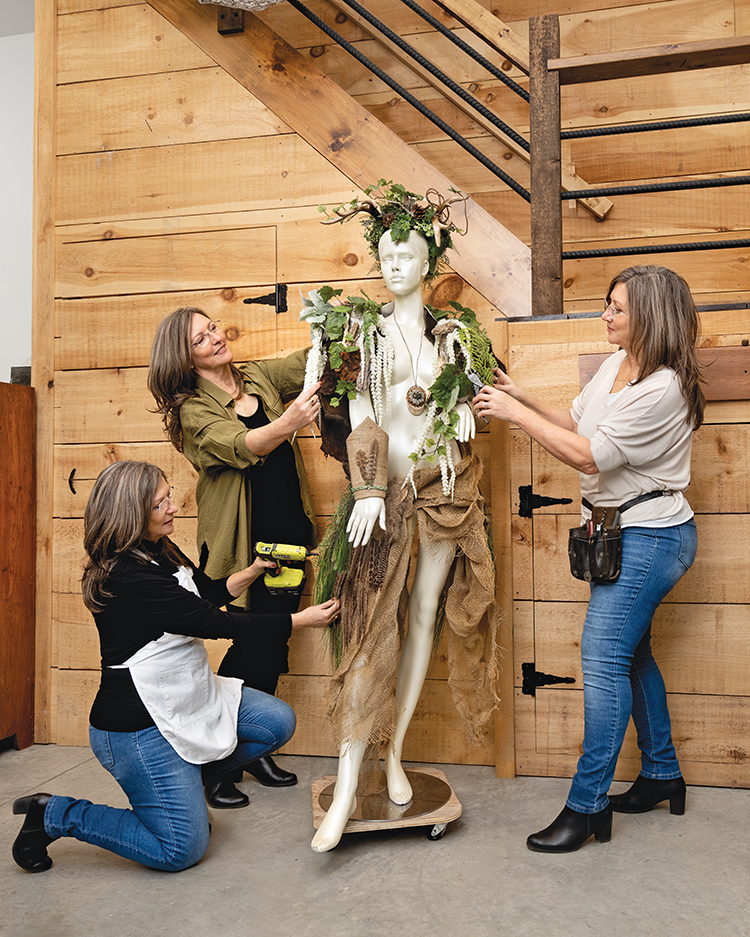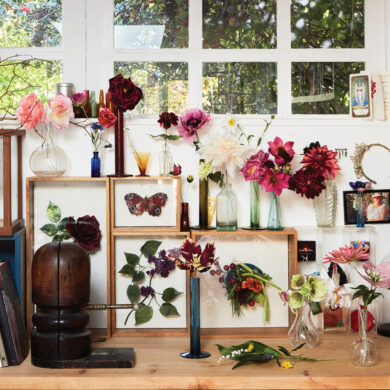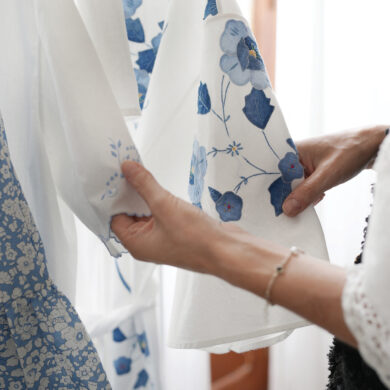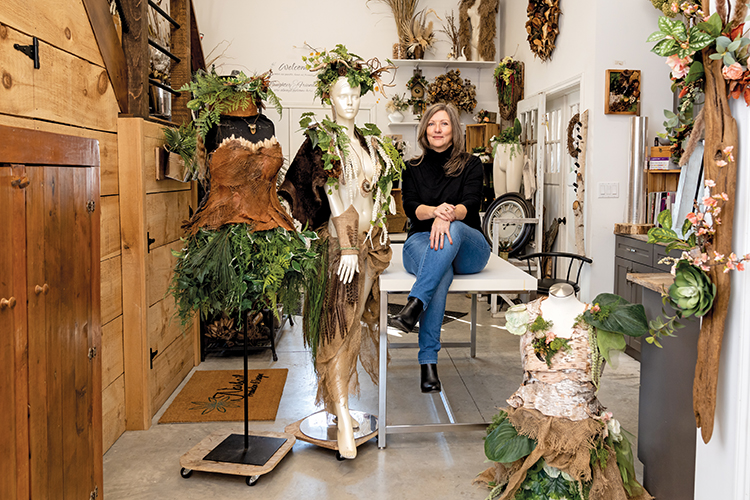
With over 40 years of experience in customer service, designing, creating, and managing my own floral business, I’ve held every possible position, and the evolution of my artistry continues. My floral adventures are always revealing exciting opportunities around every corner.
After selling my business and retiring, I knew that my work as an artist couldn’t possibly be finished. I built a two-story studio in Guelph, where I could teach workshops and classes and continue to create. It’s truly a wonderful experience getting to encourage others to follow their design dreams, along with the joy of watching students discover their potential.
I love inspiring people to find their own style and think outside of the box.
My work has won first place in a number of floral design contests and has been featured in over a dozen magazines, from floral to fashion and fantasy. In 2022, I won best in show for Toronto’s Fleurs de Villes “Femmes” competition, a floral celebration of remarkable women and an event filled with incredible subject matter and venues around Yorkville, overflowing with unique artistry.
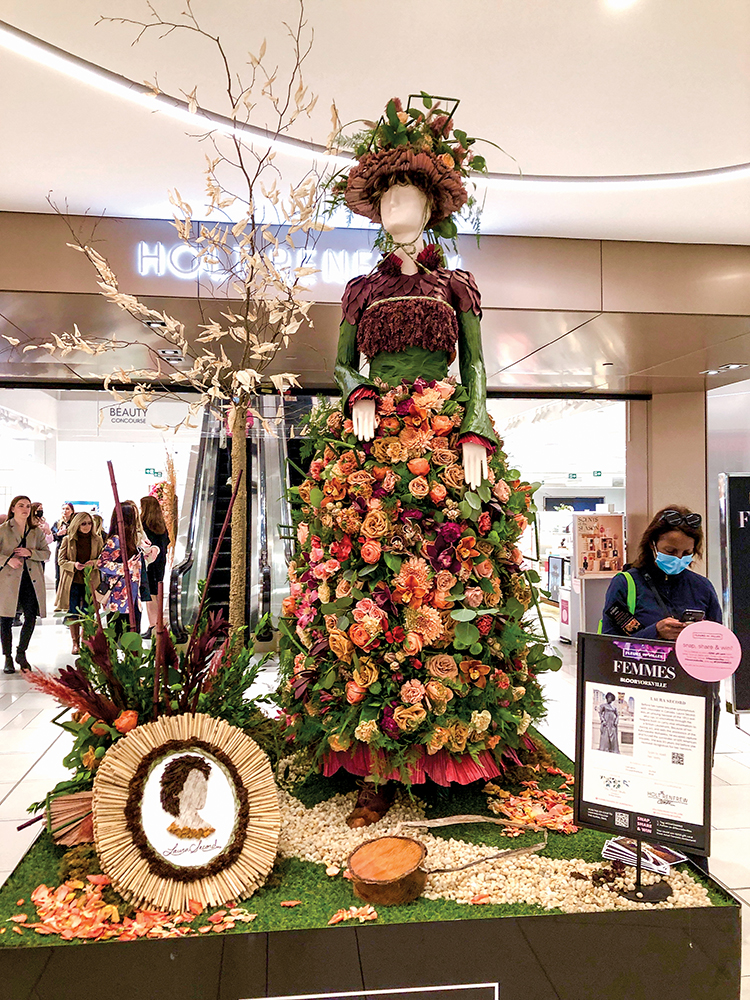
BEST IN SHOW FLEURS DE VILLES FEMMES SHOW 2022
When I got accepted to design for the Toronto Fleurs de Villes event, I was so thrilled. It’s such a great organization, showcasing and pushing the limits of floral design couture. For those of you who aren’t familiar with it, Fleurs de Villes travels the world picking floral designers to create fresh floral outfits for mannequins that are displayed for five days in high-traffic locations for the public to view. It’s amazing to see.
Each designer is chosen to create a work based on an individual person of distinction, depending on the theme. The designer is given a photo to use as inspiration for their design. Then, a mannequin is sent five to seven days before the event, and the designer creates a floral representation of that person.
My first response to the person I got was: Oh boy ….how am I going to create a floral fashion to symbolize Laura Secord? She definitely isn’t as flamboyant as Jennifer Lopez or Lady Gaga. The more I thought about it, the bigger the challenge was and the more creative I became.
To start, I put pen to paper and started drawing: Where were the parts going to start and end? The outfit had to come apart to be transported and then reassembled at the venue. What were my mechanics going to be? What would my flower choice be?
Since I hadn’t done anything like this before, so many questions were going through my head. I’ve created floral fashion in fresh and artificial, but I had never made couture of all fresh florals, for a mannequin, to last five days. I was so invested I thought about it day and night. I was excited — and nervous.
The designers were allowed to use a small amount of dried or preserved materials. So that was my starting point, and this I could do ahead of time.
The mannequin needed to be covered with plastic wrap so it didn’t get damaged. Then, two days before the event, I had the flowers delivered, cut and treated. The day before, my oasis was soaked, and it took almost two cases. The night before, I started designing and praying I had enough product.
When creating something like this, I wanted to portray who Laura was and the feeling of the era. I chose chocolate, caramel and toffee roses; a mix of bronze cymbidium orchids from red chocolate, brownie and bloodstone cymbidiums; and champagne and peach spray roses, alstroemeria and burgundy button mums and blush cremons.
There were many features of Laura Secord’s photo: She had a bonnet, curly hair, a collar, fringed shirt cuffs and a fringe around the bottom of her skirt with plain laced-up loafers. All these elements needed to shine in my design. Attention to detail is so important.
To complete my design, I needed to cover the base of the mannequin, which also had to be floral and work with the design. I created a cameo of Laura Secord as we see on her chocolates, and the water decanter, which she had with her on her walk. I made a tree for a little composition balance and a stone path to create the effect of her being outdoors. It all came together beautifully. This was such a great experience, and I was so happy to be voted best in show.
If you have the opportunity to either join or see the Fleurs de Villes show in your area, I highly recommend it: Their designs are out of this world.
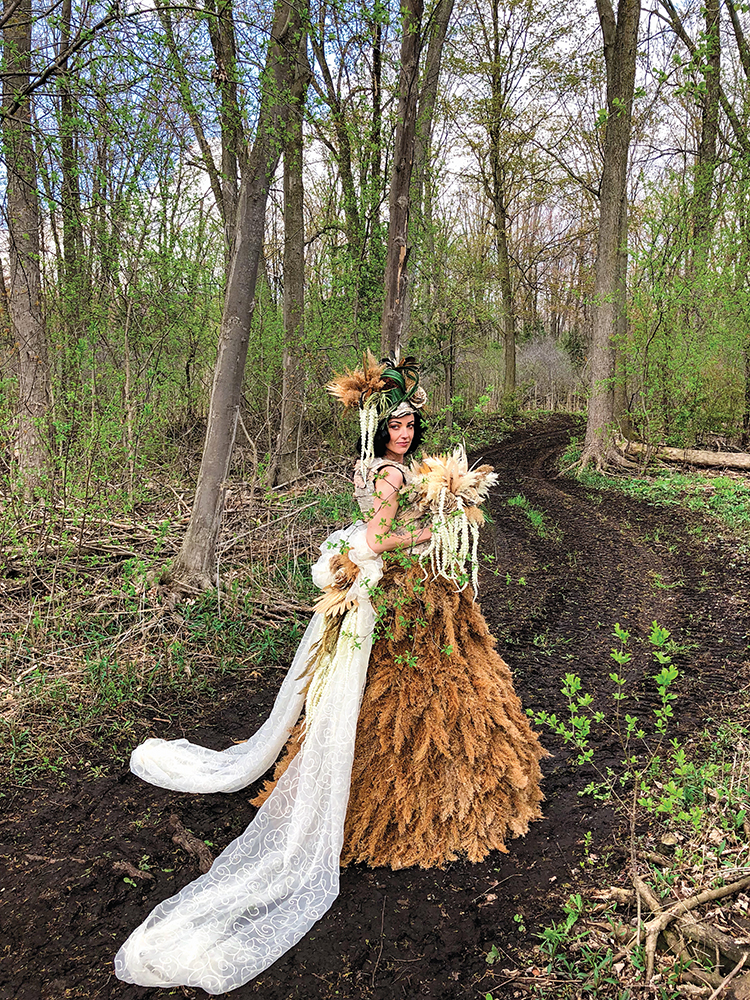
A PASSION FOR FLORAL FASHION
My love of design has taken me in many directions, but one of the most satisfying has been my endeavours in floral fashion. For the past seven years, I’ve been teaching myself how to create floral “couture.”
It all started one day when I found myself with an abundance of dusty miller. It was so beautiful with its velvety texture, silvery-gray colouring and smooth curve of the leaves. I had been thinking about trying to make an outfit — or floral “fashion” — at the time, and decided to draw a design of the mechanics of how I would house and hold these lovely leaves.
To create the dusty miller design, I formed a full long skirt from chicken wire, which opened easily at the back for wearing. I added a soft foam waistband for comfort and to cover any sharp edges, and ties to do up the skirt in the back. A dusty miller stick-on bra was created and all the leaves fanned outwards from the center, glued on using fresh floral glue (any other kind would burn the leaves).
Next, I added all the leaves to the skirt, starting at the bottom and working up and around, making sure they were facing forward and in perfect condition. Each piece was woven in and out of the chicken wire to ensure it was secure and stayed in place when the model moved. I also created a necklace, crafted from a metal necklace frame. Dusty miller leaf tips were glued to it — simple yet stunning.
Twelve hours later, it was finished. Now, for some photos: My first model was my daughter, who always supports me and my crazy ideas.
I must say my first attempt at floral fashion encouraged me to keep creating more.
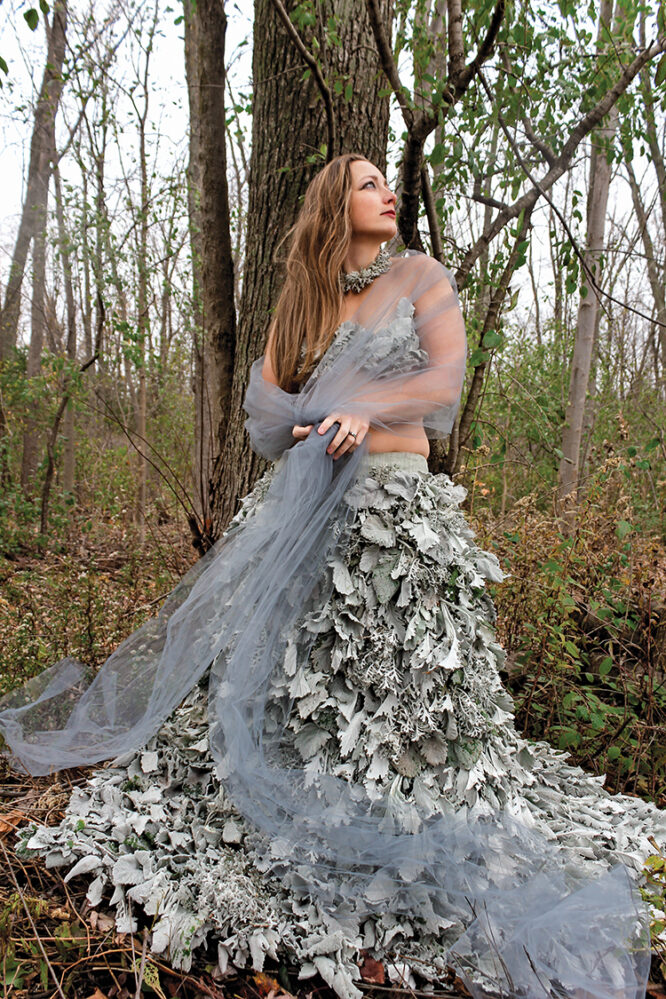
My design skills have been honed and developed over many years. I love learning about new techniques and continue to take courses from master designers around the world — artists like Hitomi Gilliam, Françoise Weeks, Brenna Quan and Sue McLeary, just to name a few.
I collect things in nature that inspire me. At the time, I have no set plan for them but, somehow, they always become a part of one of my designs. I enjoy working in mixed mediums, using both real and artificial or dried florals, plants, barks, pods, birch stones, sticks, moss, metal, etc. A large fresh floral piece can be completely transformed by adding some bark or berries, and a piece of curly willow can bring your design to life.
Just like with a painting, where the drawing is the foundational piece of the work, the mechanics of a floral design are the most important aspect. To have a successful design, you need great mechanics. I’ve always had the ability to create a vessel to house the designs I envision, thanks to the knowledge I’ve absorbed from fellow artists and master designers, and my own inventing through trial and error. I’ve been able to design and create well-constructed projects that maintain their structure and form.
A large portion of my work is custom-made for homes, offices or events. I also create for functions and photo shoots.
It seems there used to be strict rules for designing in the floral industry, many of which I break regularly. There are definitely important formulas and steps to follow when you’re first learning to design, but so much of my art is made by relying on my feelings.
One of my floral mentors told me once that I was an “instinctual designer,” designing by feeling and adding my intuition to create balance with texture and colour.
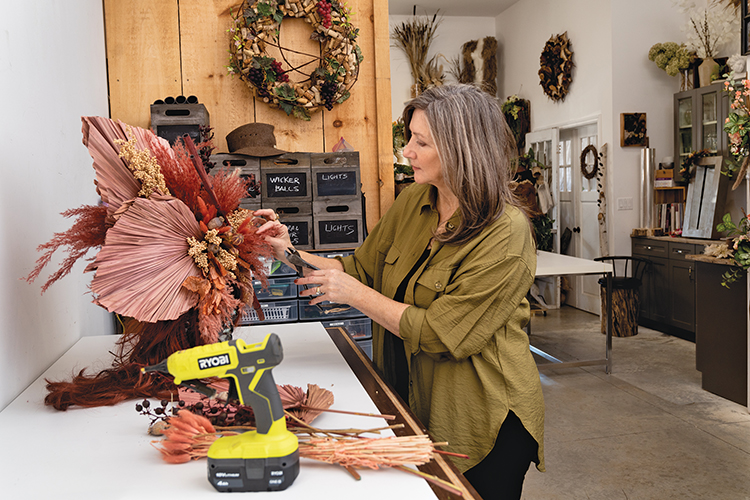
CREATING WITH LIVING AND ARTIFICIAL FLOWERS
Working with living flowers for a fashion piece is time sensitive, as they stay fresh for only two to five days, depending on the individual mechanics. Some designs can be refrigerated or put in a hydration chamber (a method invented by Gregor Lersch), which is a technique that helps to keep florals fresh and allows them to last longer.
Not all my work is done in fresh florals, because they are fragile and can only be created a few days ahead. Working with artificial and dried florals allows me the time needed for detailed work and the mobility of the fashion. The client can then see the design ahead of time and request changes if needed. If the fashion is created for a photo shoot or event, transporting it is much easier and the models can normally get ready themselves. It also makes the floral fashion lighter, as working with real flowers can get very heavy.
Once a design is finished and ready for an event, a final fitting is done. Next, the models need their makeup and hair done, and professional makeup artists and hair stylists are brought in. This can take a few hours.
For some events, the photographer comes in to take photos before the event — or if the fashion is done solely for a photo shoot. (Not all event fashions have photo shoots.)
This collaboration is when the magic happens, and the design is brought to life. Each photo shoot can take anywhere from three to six hours. If there is more than one model and more than one location where pictures are being taken, it’s a full day. The photographer puts their final touches on the photos and voila!: magazine-ready.
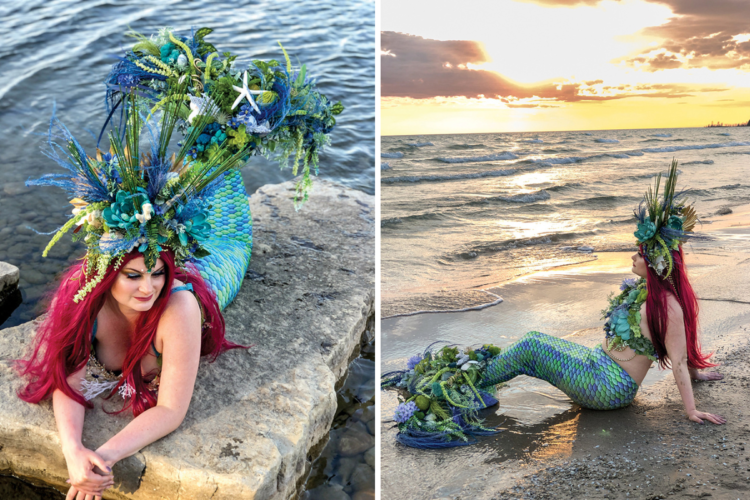
MERMAIDS AND MYSTICAL CREATURES
For this project, I designed a fantasy mermaid for a model who wanted shots for her portfolio. I knew I wanted to have a few options for both the headpieces and the costume, especially since there wasn’t an actual fitting and I was working only from the model’s measurements.
Flexibility is key, as adjustments often have to be made on-site if needed. My design was created in blue and green teal, with two headpieces: a large crown and a smaller tiara. There were two tops: One, a bra-style covered in moss, seashells and gems; and the other, a halter-style top with succulents, mosses, foliage and beads. Her tail fin was decorated with mosses, shells, blue pampas grass and assorted florals.
NARBAIL PRODUCTIONS MEETS NARNIA
I was recently commissioned to create a “Narnia enchanted garden” event for a large technology company. They needed an impressive entrance table designed that was 5 feet wide by 16 feet long. Included in the landscape were large stumps and tree branches adorned with fairy lights. The table dripped with moss, bark, orchids and lanterns that hung from the branches. On each table, there were small wooden pedestal containers filled with succulents, mosses and bark.
The best part for me was creating the fashions.
I made three natural, mixed-media outfits and headpieces for the enchanted Narnia models to wear; they were the perfect addition to the magical garden. The job of the models was to wander around getting their pictures taken and mingling with the guests.
I had so much fun making their forest fashion, which can be tricky as the costumes have to be strong enough to withhold movement, yet comfortable for the models to wear for an extended period of time. This is where good mechanics come into play.
One was adorned with a fur shawl dripping in vines and hanging Amaranthus, his warrior cuffs accented with feathers and braided bear grass, with a birch necklace made from a small slab of birch and pussy willow buds. His costume was completed with an antlered headpiece and a staff with an amber glass globe and trailing vines.
Another model had a birchbark top with a cabbage-leaf petalled skirt dripping with burlap and vines. A matching birch headpiece with wood roses, assorted foliage and pointed elf ears completed the look.
The third model had a corset made from large pieces of palm bark, trimmed with dried bunny tails. Complementing her look were cuffs made with twine and matching bunny tail accents. A full ivy and fern foliage skirt finished her outfit. A necklace was added, made from a piece of a pine cone, a touch of foliage and a few berries. This model even had a long fur tail — very Narnia.
Mission accomplished.
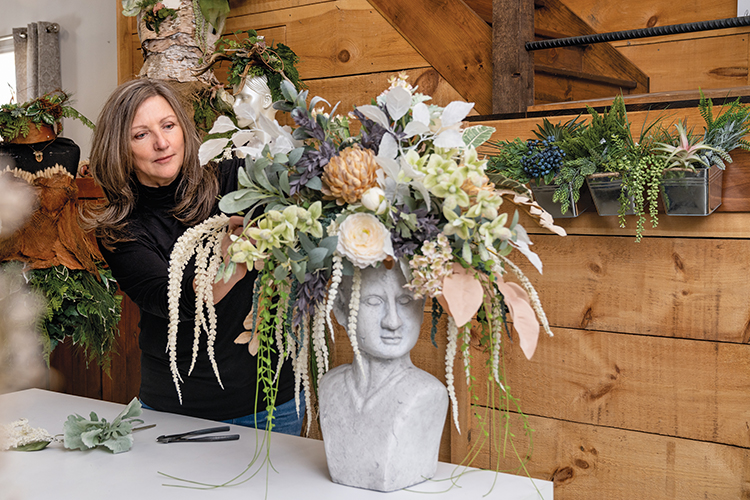
Creating for me is a bit of an obsession. It affects everything I do. Even when I’m cooking, following a recipe is hard for me. I love to put my own twist on everything I do.
Sometimes the ideas flow so fast you can’t keep up with them, and this is when the sketchbook or notebook comes out. Other times, I’ve got nothing and that’s OK. If there is any advice I can give to other creators or designers, it’s: Don’t stress yourself out, take a walk, listen to some music, look at a book or flip through a magazine. Give yourself time to refocus and recharge. Being creative is a process.
None of what I do would be possible without the talent and expertise of the people who help to make the magic happen. First and most important, is my husband, Bruce, who is always there to set up, take down and build props for me.
I’m also grateful for my models, hairstylists, makeup artists and amazing photographers. A very special thanks goes to my own dream team: Paige Potter, photographer; Alex Dekker, photographer; Rachael Jones, makeup artist, hair and photography; Jesse Botero, makeup artist; Heather Wickert, model; Katie Pew and Frank Pew, models; Bailey Reid, model; and Terra Greenough, model.

With over 40 years of experience in customer service, designing, creating, and managing my own floral business, I’ve held every possible position, and the evolution of my artistry continues. My floral adventures are always revealing exciting opportunities around every corner.
After selling my business and retiring, I knew that my work as an artist couldn’t possibly be finished. I built a two-story studio in Guelph, where I could teach workshops and classes and continue to create. It’s truly a wonderful experience getting to encourage others to follow their design dreams, along with the joy of watching students discover their potential.
I love inspiring people to find their own style and think outside of the box.
My work has won first place in a number of floral design contests and has been featured in over a dozen magazines, from floral to fashion and fantasy. In 2022, I won best in show for Toronto’s Fleurs de Villes “Femmes” competition, a floral celebration of remarkable women and an event filled with incredible subject matter and venues around Yorkville, overflowing with unique artistry.

BEST IN SHOW FLEURS DE VILLES FEMMES SHOW 2022
When I got accepted to design for the Toronto Fleurs de Villes event, I was so thrilled. It’s such a great organization, showcasing and pushing the limits of floral design couture. For those of you who aren’t familiar with it, Fleurs de Villes travels the world picking floral designers to create fresh floral outfits for mannequins that are displayed for five days in high-traffic locations for the public to view. It’s amazing to see.
Each designer is chosen to create a work based on an individual person of distinction, depending on the theme. The designer is given a photo to use as inspiration for their design. Then, a mannequin is sent five to seven days before the event, and the designer creates a floral representation of that person.
My first response to the person I got was: Oh boy ….how am I going to create a floral fashion to symbolize Laura Secord? She definitely isn’t as flamboyant as Jennifer Lopez or Lady Gaga. The more I thought about it, the bigger the challenge was and the more creative I became.
To start, I put pen to paper and started drawing: Where were the parts going to start and end? The outfit had to come apart to be transported and then reassembled at the venue. What were my mechanics going to be? What would my flower choice be?
Since I hadn’t done anything like this before, so many questions were going through my head. I’ve created floral fashion in fresh and artificial, but I had never made couture of all fresh florals, for a mannequin, to last five days. I was so invested I thought about it day and night. I was excited — and nervous.
The designers were allowed to use a small amount of dried or preserved materials. So that was my starting point, and this I could do ahead of time.
The mannequin needed to be covered with plastic wrap so it didn’t get damaged. Then, two days before the event, I had the flowers delivered, cut and treated. The day before, my oasis was soaked, and it took almost two cases. The night before, I started designing and praying I had enough product.
When creating something like this, I wanted to portray who Laura was and the feeling of the era. I chose chocolate, caramel and toffee roses; a mix of bronze cymbidium orchids from red chocolate, brownie and bloodstone cymbidiums; and champagne and peach spray roses, alstroemeria and burgundy button mums and blush cremons.
There were many features of Laura Secord’s photo: She had a bonnet, curly hair, a collar, fringed shirt cuffs and a fringe around the bottom of her skirt with plain laced-up loafers. All these elements needed to shine in my design. Attention to detail is so important.
To complete my design, I needed to cover the base of the mannequin, which also had to be floral and work with the design. I created a cameo of Laura Secord as we see on her chocolates, and the water decanter, which she had with her on her walk. I made a tree for a little composition balance and a stone path to create the effect of her being outdoors. It all came together beautifully. This was such a great experience, and I was so happy to be voted best in show.
If you have the opportunity to either join or see the Fleurs de Villes show in your area, I highly recommend it: Their designs are out of this world.

A PASSION FOR FLORAL FASHION
My love of design has taken me in many directions, but one of the most satisfying has been my endeavours in floral fashion. For the past seven years, I’ve been teaching myself how to create floral “couture.”
It all started one day when I found myself with an abundance of dusty miller. It was so beautiful with its velvety texture, silvery-gray colouring and smooth curve of the leaves. I had been thinking about trying to make an outfit — or floral “fashion” — at the time, and decided to draw a design of the mechanics of how I would house and hold these lovely leaves.
To create the dusty miller design, I formed a full long skirt from chicken wire, which opened easily at the back for wearing. I added a soft foam waistband for comfort and to cover any sharp edges, and ties to do up the skirt in the back. A dusty miller stick-on bra was created and all the leaves fanned outwards from the center, glued on using fresh floral glue (any other kind would burn the leaves).
Next, I added all the leaves to the skirt, starting at the bottom and working up and around, making sure they were facing forward and in perfect condition. Each piece was woven in and out of the chicken wire to ensure it was secure and stayed in place when the model moved. I also created a necklace, crafted from a metal necklace frame. Dusty miller leaf tips were glued to it — simple yet stunning.
Twelve hours later, it was finished. Now, for some photos: My first model was my daughter, who always supports me and my crazy ideas.
I must say my first attempt at floral fashion encouraged me to keep creating more.

My design skills have been honed and developed over many years. I love learning about new techniques and continue to take courses from master designers around the world — artists like Hitomi Gilliam, Françoise Weeks, Brenna Quan and Sue McLeary, just to name a few.
I collect things in nature that inspire me. At the time, I have no set plan for them but, somehow, they always become a part of one of my designs. I enjoy working in mixed mediums, using both real and artificial or dried florals, plants, barks, pods, birch stones, sticks, moss, metal, etc. A large fresh floral piece can be completely transformed by adding some bark or berries, and a piece of curly willow can bring your design to life.
Just like with a painting, where the drawing is the foundational piece of the work, the mechanics of a floral design are the most important aspect. To have a successful design, you need great mechanics. I’ve always had the ability to create a vessel to house the designs I envision, thanks to the knowledge I’ve absorbed from fellow artists and master designers, and my own inventing through trial and error. I’ve been able to design and create well-constructed projects that maintain their structure and form.
A large portion of my work is custom-made for homes, offices or events. I also create for functions and photo shoots.
It seems there used to be strict rules for designing in the floral industry, many of which I break regularly. There are definitely important formulas and steps to follow when you’re first learning to design, but so much of my art is made by relying on my feelings.
One of my floral mentors told me once that I was an “instinctual designer,” designing by feeling and adding my intuition to create balance with texture and colour.

CREATING WITH LIVING AND ARTIFICIAL FLOWERS
Working with living flowers for a fashion piece is time sensitive, as they stay fresh for only two to five days, depending on the individual mechanics. Some designs can be refrigerated or put in a hydration chamber (a method invented by Gregor Lersch), which is a technique that helps to keep florals fresh and allows them to last longer.
Not all my work is done in fresh florals, because they are fragile and can only be created a few days ahead. Working with artificial and dried florals allows me the time needed for detailed work and the mobility of the fashion. The client can then see the design ahead of time and request changes if needed. If the fashion is created for a photo shoot or event, transporting it is much easier and the models can normally get ready themselves. It also makes the floral fashion lighter, as working with real flowers can get very heavy.
Once a design is finished and ready for an event, a final fitting is done. Next, the models need their makeup and hair done, and professional makeup artists and hair stylists are brought in. This can take a few hours.
For some events, the photographer comes in to take photos before the event — or if the fashion is done solely for a photo shoot. (Not all event fashions have photo shoots.)
This collaboration is when the magic happens, and the design is brought to life. Each photo shoot can take anywhere from three to six hours. If there is more than one model and more than one location where pictures are being taken, it’s a full day. The photographer puts their final touches on the photos and voila!: magazine-ready.

MERMAIDS AND MYSTICAL CREATURES
For this project, I designed a fantasy mermaid for a model who wanted shots for her portfolio. I knew I wanted to have a few options for both the headpieces and the costume, especially since there wasn’t an actual fitting and I was working only from the model’s measurements.
Flexibility is key, as adjustments often have to be made on-site if needed. My design was created in blue and green teal, with two headpieces: a large crown and a smaller tiara. There were two tops: One, a bra-style covered in moss, seashells and gems; and the other, a halter-style top with succulents, mosses, foliage and beads. Her tail fin was decorated with mosses, shells, blue pampas grass and assorted florals.
NARBAIL PRODUCTIONS MEETS NARNIA
I was recently commissioned to create a “Narnia enchanted garden” event for a large technology company. They needed an impressive entrance table designed that was 5 feet wide by 16 feet long. Included in the landscape were large stumps and tree branches adorned with fairy lights. The table dripped with moss, bark, orchids and lanterns that hung from the branches. On each table, there were small wooden pedestal containers filled with succulents, mosses and bark.
The best part for me was creating the fashions.
I made three natural, mixed-media outfits and headpieces for the enchanted Narnia models to wear; they were the perfect addition to the magical garden. The job of the models was to wander around getting their pictures taken and mingling with the guests.
I had so much fun making their forest fashion, which can be tricky as the costumes have to be strong enough to withhold movement, yet comfortable for the models to wear for an extended period of time. This is where good mechanics come into play.
One was adorned with a fur shawl dripping in vines and hanging Amaranthus, his warrior cuffs accented with feathers and braided bear grass, with a birch necklace made from a small slab of birch and pussy willow buds. His costume was completed with an antlered headpiece and a staff with an amber glass globe and trailing vines.
Another model had a birchbark top with a cabbage-leaf petalled skirt dripping with burlap and vines. A matching birch headpiece with wood roses, assorted foliage and pointed elf ears completed the look.
The third model had a corset made from large pieces of palm bark, trimmed with dried bunny tails. Complementing her look were cuffs made with twine and matching bunny tail accents. A full ivy and fern foliage skirt finished her outfit. A necklace was added, made from a piece of a pine cone, a touch of foliage and a few berries. This model even had a long fur tail — very Narnia.
Mission accomplished.

Creating for me is a bit of an obsession. It affects everything I do. Even when I’m cooking, following a recipe is hard for me. I love to put my own twist on everything I do.
Sometimes the ideas flow so fast you can’t keep up with them, and this is when the sketchbook or notebook comes out. Other times, I’ve got nothing and that’s OK. If there is any advice I can give to other creators or designers, it’s: Don’t stress yourself out, take a walk, listen to some music, look at a book or flip through a magazine. Give yourself time to refocus and recharge. Being creative is a process.
None of what I do would be possible without the talent and expertise of the people who help to make the magic happen. First and most important, is my husband, Bruce, who is always there to set up, take down and build props for me.
I’m also grateful for my models, hairstylists, makeup artists and amazing photographers. A very special thanks goes to my own dream team: Paige Potter, photographer; Alex Dekker, photographer; Rachael Jones, makeup artist, hair and photography; Jesse Botero, makeup artist; Heather Wickert, model; Katie Pew and Frank Pew, models; Bailey Reid, model; and Terra Greenough, model.








